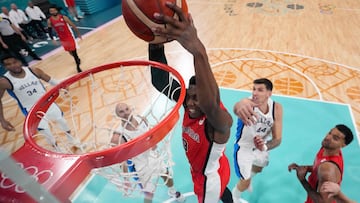What are the differences between the NBA and FIBA basketball? Duration, fouls, 3-pointers, rules...
While basketball is adored across the globe, Olympic basketball differs from the NBA in that it operates under FIBA rules and regulations. We look at their differences.

Basketball is a globally adored sport - one that is played under different sets of rules depending on who the competition organizers are. Two of the most prominent bodies in the basketball world are FIBA (Fédération Internationale de Basketball) and the NBA (National Basketball Association). While both share the same objective of putting the ball through the opponent’s hoop, there are several key differences in rules that distinguish FIBA from the NBA.
FIBA is world basketball’s governing body while the NBA is the major professional basketball league in the United States and Canada, and many would say the best basketball league on the planet too. FIBA meanwhile, organizes a host of international tournaments such as the various different categories of the World Cup - and it’s rules and regulations are used at the Olympic Games. So let’s look at how they differ.
From another galaxy 👽#Paris2024 x #Basketball pic.twitter.com/EKZbHnM7Mb
— FIBA (@FIBA) July 27, 2024
Differences and similarities between FIBA and NBA rules
Firstly, the playing court dimensions differ between FIBA and the NBA. FIBA courts are slightly smaller, measuring at 28 meters (91.9 feet) in length and 15 meters (49.2 feet) in width. NBA courts are 94 feet in length and 50 feet in width. This variation in court size can influence the pace of the game and player positioning.
The second big difference is game duration. FIBA games consist of four quarters, each lasting for 10 minutes, summing up to a total of 40 minutes. In contrast, NBA games are played over four quarters, but each quarter is 12 minutes long, amounting to a 48-minute game. This difference in game duration can impact team strategies, player substitutions, and overall game intensity.
At today's #NBAAllStar2024 press conference, @NBA commissioner Adam Silver announced the All-Star Game will return to East vs. West and the traditional scoring system with four 12-minute quarters.
— Indiana Pacers (@Pacers) October 25, 2023
"It's fitting with the theme for this entire season...It's back to basketball." pic.twitter.com/Ygr6zzgrar
Another noteworthy distinction lies in the shot clock duration. In FIBA, teams have 24 seconds to attempt a shot, while the NBA offers a slightly shorter window of 14 seconds. This variance can lead to different pacing and offensive strategies in the two leagues, with NBA teams needing to make quicker decisions.
Fouls and free throws also have distinct regulations. In FIBA, players are allowed five personal fouls before being disqualified from the game, whereas the NBA imposes a six-foul limit.
Embiid dime.
— NBA (@NBA) July 22, 2024
LBJ showtime. https://t.co/nDTfpDTRjr pic.twitter.com/P5yR5xdDzw
Free throw rules and goaltending
Additionally, free throw rules also differ: FIBA awards two free throws after the opposing team’s fifth team foul in each quarter, while the NBA gives two free throws after the opposing team’s fourth team foul in each quarter.
Related stories
Lastly, the goaltending rules diverge. In FIBA, once the ball touches the rim, it is considered live and can be played by any player, regardless of its trajectory. However, in the NBA, goaltending is prohibited – no player can interfere with a shot once it’s on a downward trajectory towards the rim. This discrepancy can significantly influence defensive strategies and the timing of shot attempts.
From court dimensions and game duration to shot clock timing, foul limits, and goaltending regulations, these variations contribute to unique playing styles and strategies in each league. As basketball continues to capture hearts around the world, these rule differences serve to remind us of the dynamic nature of the sport and the diversity of approaches it can accommodate.


Complete your personal details to comment